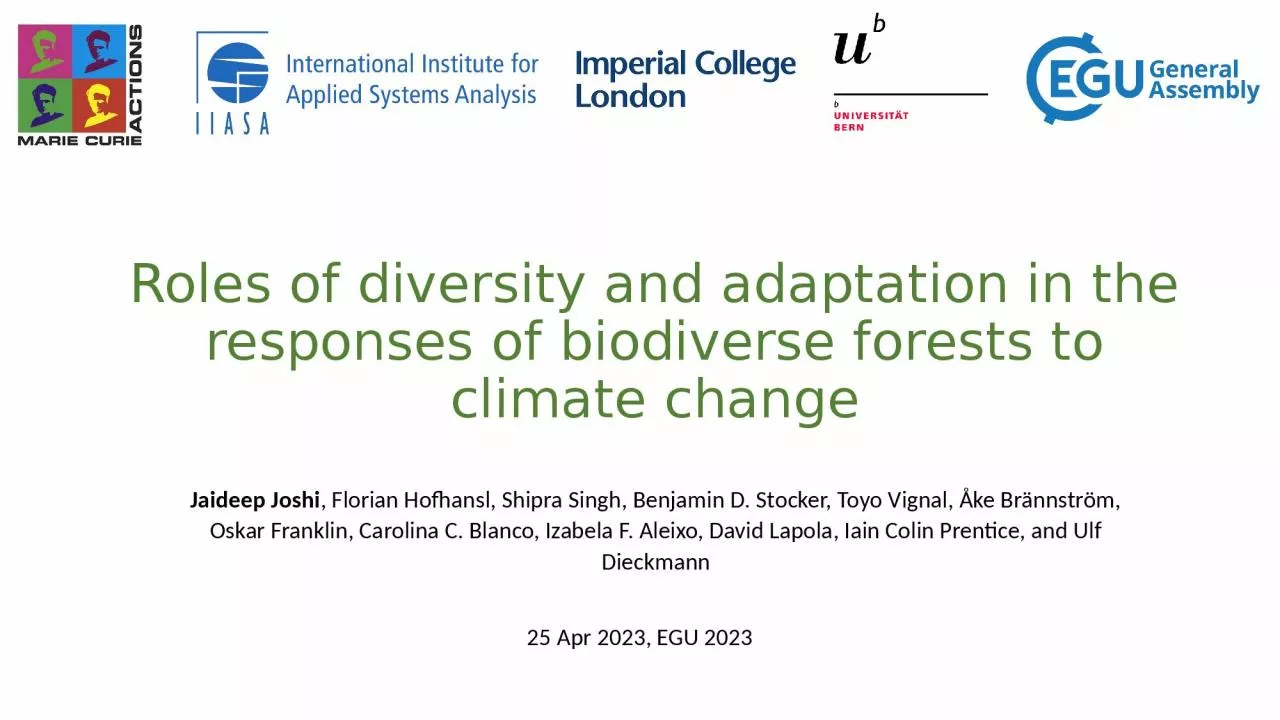

25 Apr 2023 EGU 2023 Jaideep Joshi Florian Hofhansl Shipra Singh Benjamin D Stocker Toyo Vignal Åke Brännström Oskar Franklin Carolina C Blanco Izabela F Aleixo David ID: 1018765
Download Presentation The PPT/PDF document "Roles of diversity and adaptation in the..." is the property of its rightful owner. Permission is granted to download and print the materials on this web site for personal, non-commercial use only, and to display it on your personal computer provided you do not modify the materials and that you retain all copyright notices contained in the materials. By downloading content from our website, you accept the terms of this agreement.
1. Roles of diversity and adaptation in the responses of biodiverse forests to climate change25 Apr 2023, EGU 2023Jaideep Joshi, Florian Hofhansl, Shipra Singh, Benjamin D. Stocker, Toyo Vignal, Åke Brännström, Oskar Franklin, Carolina C. Blanco, Izabela F. Aleixo, David Lapola, Iain Colin Prentice, and Ulf Dieckmann
2. How does a biodiverse ecosystem respond to climate change?TimescalesOrganizational levelsHours-months Years-decades CenturiesIndividualSpeciesCommunityPlastic trait acclimationDemographic community shiftsSpecies genetic evolutionFunctional diversity,Species interactionsIntraspecific variationPhenotypic plasticity2Community compositionEvolutionarily stable strategiesFluxes
3. How does a biodiverse ecosystem respond to climate change?TimescalesOrganizational levelsHours-months Years-decades CenturiesIndividualSpeciesCommunityPlastic trait acclimationDemographic community shiftsSpecies genetic evolutionDroughtMortality ↑Stand age ↓Successional stage ↓3Community compositionEvolutionarily stable strategiesFluxese-CO2 GPP ↑ ↓ ↓ DroughtGPP ↓ ↓ ↓ DroughtXylem ↓ (?)
4. Species evolution Evolutionary dynamicsPlant-FATE: Our eco-evolutionary vegetation modelImage Credits: Muffet, Huw WilliamsDays - MonthsCenturiesYears - DecadesPhysiological acclimation Optimality principlesVegetation demographicsSize-structured population modellingCompetition for light and water, demographic processesOptimal photosynthesis, hydraulics, allocationHeight-structuredlight competitionSoil moisture stressPlant physiology4Gradual ascension of the fitness landscape
5. We address four key QuestionsWhat are the changes in fluxes (GPP, transpiration) under elevated CO2 (eCO2) compared to ambient CO2 (aCO2)?What are the timescales of responses at the three organizational levels? Are there potential species shifts under eCO2?What are the ESS strategies under different CO2 and moisture regimes?
6. We apply the model to a hyperdiverse Amazonian forest6AbundanceTraitAbundanceTraitCO2 (ppm)614414AbundanceTraitForced with periodic extension of observed meteorological data from 2000-2015Species defined as unique combinations of 4 traits: LMA, max. height, wood density, xylem Start with 100 species with random trait values with equal abundanceLet community composition evolve via competitive exclusion
7. GPP increases, transpiration decreases under eCO27Observed range
8. Community shifts to larger trees and species with lower wood density under eCO28Predictions (aCO2) Predictions (eCO2) Observations
9. Community responds on three timescales92. Demographic change due to changing light environment 500 years 3. Evolutionary change due to changing species composition 2000 years 1. Physiological response in increased leaf-level photosynthesis 1 year
10. Population-environment feedbacks alter the direction of the community shift 10Predicted optimal wood density (for different combinations of LMA, Max Height, and P50)BaselineeCO2 but no change in vertical light profileeCO2 with demographic feedbacks on light profile
11. Quick preliminary result on droughtESS Xylem increases with soil water potential 11Soil water potential (MPa)ESS Xylem (MPa)
12. Take home messagesThe Plant-FATE model correctly predicts ecosystem fluxes, forest structure, and species composition under ambient CO2 Under elevated CO2, productivity increases but community shifts to lower wood densityThe direction of the shift is determined by feedbacks between forest structure and the environmentNot accounting for environmental feedbacks can predict opposite outcomes12
13. Thank you13Questions? jaideep.joshi@giub.unibe.ch